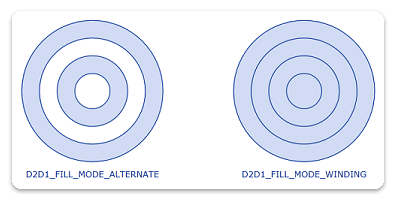Come creare gruppi geometry
Questo argomento descrive come creare gruppi geometry.
Per creare un gruppo geometry, chiamare il metodo ID2D1Factory::CreateGeometryGroup e specificare una matrice di geometrie e una modalità riempimento.
Quando si combinano geometrie in un gruppo geometry, assicurarsi che le geometrie siano orientate in modo analogo. Se non si è certi dell'orientamento delle geometrie, chiamare ID2D1Geometry::Struttura in ognuno di essi singolarmente e quindi inserire le geometrie risultanti nel gruppo geometry.
Nell'esempio di codice seguente viene illustrata la creazione di quattro cerchi concentrici: il primo cerchio ha un raggio pari a 25, il secondo 50, il terzo 75 e il quarto 100. Il codice mostra anche l'istanza di una matrice di geometrie, nonché le due chiamate a CreateGeometryGroup.
HRESULT DemoApp::CreateGeometryResources()
{
HRESULT hr;
const D2D1_ELLIPSE ellipse1 = D2D1::Ellipse(
D2D1::Point2F(105.0f, 105.0f),
25.0f,
25.0f
);
hr = m_pD2DFactory->CreateEllipseGeometry(
ellipse1,
&m_pEllipseGeometry1
);
if (SUCCEEDED(hr))
{
const D2D1_ELLIPSE ellipse2 = D2D1::Ellipse(
D2D1::Point2F(105.0f, 105.0f),
50.0f,
50.0f
);
hr = m_pD2DFactory->CreateEllipseGeometry(
ellipse2,
&m_pEllipseGeometry2
);
}
if (SUCCEEDED(hr))
{
const D2D1_ELLIPSE ellipse3 = D2D1::Ellipse(
D2D1::Point2F(105.0f, 105.0f),
75.0f,
75.0f
);
hr = m_pD2DFactory->CreateEllipseGeometry(
ellipse3,
&m_pEllipseGeometry3
);
}
if (SUCCEEDED(hr))
{
const D2D1_ELLIPSE ellipse4 = D2D1::Ellipse(
D2D1::Point2F(105.0f, 105.0f),
100.0f,
100.0f
);
hr = m_pD2DFactory->CreateEllipseGeometry(
ellipse4,
&m_pEllipseGeometry4
);
}
if (SUCCEEDED(hr))
{
ID2D1Geometry *ppGeometries[] =
{
m_pEllipseGeometry1,
m_pEllipseGeometry2,
m_pEllipseGeometry3,
m_pEllipseGeometry4
};
hr = m_pD2DFactory->CreateGeometryGroup(
D2D1_FILL_MODE_ALTERNATE,
ppGeometries,
ARRAYSIZE(ppGeometries),
&m_pGeoGroup_AlternateFill
);
if (SUCCEEDED(hr))
{
hr = m_pD2DFactory->CreateGeometryGroup(
D2D1_FILL_MODE_WINDING,
ppGeometries,
ARRAYSIZE(ppGeometries),
&m_pGeoGroup_WindingFill
);
}
}
return hr;
}
Disegno e riempimento di gruppi geometry
Per disegnare e compilare un gruppo geometry, usare i metodi ID2D1RenderTarget::FillGeometry e ID2D1RenderTarget::D rawGeometry. Nell'esempio di codice seguente viene illustrato come disegnare e riempire un gruppo geometry.
HRESULT DemoApp::OnRender()
{
HRESULT hr = CreateDeviceResources();
if (SUCCEEDED(hr))
{
static const WCHAR sc_fillModeAlternateText[] = L"D2D1_FILL_MODE_ALTERNATE";
static const WCHAR sc_fillModeWindingText[] = L"D2D1_FILL_MODE_WINDING";
m_pRenderTarget->BeginDraw();
m_pRenderTarget->SetTransform(D2D1::Matrix3x2F::Identity());
m_pRenderTarget->Clear(D2D1::ColorF(D2D1::ColorF::White));
D2D1_SIZE_F rtSize = m_pRenderTarget->GetSize();
m_pRenderTarget->FillRectangle(
D2D1::RectF(0.0f, 0.0f, rtSize.width, rtSize.height),
m_pGridPatternBitmapBrush
);
// Centers the text in a layout rectangle.
hr = m_pTextFormat->SetTextAlignment(DWRITE_TEXT_ALIGNMENT_CENTER);
if (SUCCEEDED(hr))
{
// Fill the geometry group with D2D1_FILL_MODE_ALTERNATE and
// then draw the geometries in the group.
m_pRenderTarget->FillGeometry(m_pGeoGroup_AlternateFill, m_pFillBrush);
m_pRenderTarget->DrawGeometry(m_pGeoGroup_AlternateFill, m_pStrokeBrush, 1.0f);
m_pRenderTarget->DrawText(
sc_fillModeAlternateText,
ARRAYSIZE(sc_fillModeAlternateText) - 1,
m_pTextFormat,
D2D1::RectF(5, 215, 205, 240),
m_pStrokeBrush,
D2D1_DRAW_TEXT_OPTIONS_NONE,
DWRITE_MEASURING_MODE_NATURAL
);
m_pRenderTarget->SetTransform(D2D1::Matrix3x2F::Translation(300, 0));
// Fill the geometry group with D2D1_FILL_MODE_WINDING and
// then draw the geometries in the group.
m_pRenderTarget->FillGeometry(m_pGeoGroup_WindingFill, m_pFillBrush);
m_pRenderTarget->DrawGeometry(m_pGeoGroup_WindingFill, m_pStrokeBrush, 1.0f);
m_pRenderTarget->DrawText(
sc_fillModeWindingText,
ARRAYSIZE(sc_fillModeWindingText) - 1,
m_pTextFormat,
D2D1::RectF(5, 215, 205, 240),
m_pStrokeBrush,
D2D1_DRAW_TEXT_OPTIONS_NONE,
DWRITE_MEASURING_MODE_NATURAL
);
hr = m_pRenderTarget->EndDraw();
if (hr == D2DERR_RECREATE_TARGET)
{
hr = S_OK;
DiscardDeviceResources();
}
}
}
return hr;
}
Il codice produce l'output illustrato nella figura seguente.
